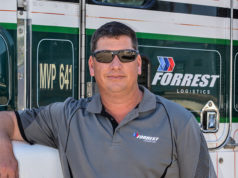
Photo credit: Ricky French
Mother Nature was no deterrent for Loscam, which overcame destructive floods in 2011 to flourish at a new site
In January 2011, the team at the Loscam pallet repair facility in Rockleigh, Brisbane faced what can only be described as less than ideal working conditions: their building was under four metres of water.
A massive dump of rain hit the low-lying area and lifted 80,000 pallets off the ground, turning them into impromptu rafts. Filing cabinets were deposited on top of tables, phone lines and electricity was cut.
A Channel 9 helicopter hovered overhead, bringing live coverage of the devastation to viewers around Australia.
The facility was out of action for three months, and 5000 pallets were lost. When the team finally moved back in there was still no power or phone, and it was the middle of summer.
Queensland state manager Irene Radford is clearly employing liberal use of understatement when she says: “It was a challenge.”
 |
|
Pallet repairs get it down to a fine art
|
Today, Radford and the rest of the 45-50 strong crew are in much more comfortable surroundings, having just settled in to their brand new, purpose-built pallet repair facility located nearby in Richlands.
The site was chosen for many reasons, not least because it’s on higher ground.
While no one wants their workday to be boring, there’s only so much excitement you can really take.
NEEDS OF THE FACILITY
Loscam had specific requirements for the new facility, due to the specific nature of its function: to process the checking and repair of returned pallets as efficiently and quickly as possible.
The pooling business has experienced “fantastic growth in market share” over the last decade, according to executive vice president, Australia and New Zealand, Daniel Bunnett.
 |
|
Loscam exectutive vice president Australia and New Zealand, Daniel Bunnett
|
Loscam has over 3500 Australian customers, with the biggest moving thousands of pallets every day. Part of that growth, according to Bunnett, is due to the quality of pallets Loscam send out.
In the age of automated picking cranes and warehouse, customers are demanding an exceptional and consistent standard of pallet.
A pallet that has been shunted or damaged to the point of not being square any more can cause enormous headaches for automated warehouses, while protruding nails and damaged board comprise safety for everyone involved.
Having high quality pallets is critical, but it’s not easily done in the rough and tumble world of transport and pallet hire. Loscam is cornering the market that requires high-end, top quality pallets.
As Bunnett explains: “Having this high standard of pallets means our customers have the confidence to go out and make these investments in automated warehouses.”
To ensure every pallet that is returned to Loscam gets checked and repaired if required the company has made considerable investment in their own automated technology.
 |
|
The new Brisbane facility has room for 125,000 pallets
|
A TOUR OF THE SITE
ATN visits the Richlands site in week seven of operation. The team is building up to capacity and honing improvements every day.
Trucks returning pallets are unloaded in a spacious loading dock and the pallets are forklifted to the start of one of the two repair lines running in opposite directions along the length of the building.
“There’s no pre-assumption with our pallets,” says Bunnett. “They’re all checked.” Common damage to pallets included nail protrusion and damaged boards due to forklift shunting and general knocks when loading into trucks.
“The only true way of determining if a pallet is fit for purpose is to do an individual inspection.”
 |
|
AMS automated stackers distribute pallets one at a time to the sorter
|
The stack of pallets due for inspection and repair gets deposited to the automated “stacker” which picks the bottom pallet and sends it along a conveyer belt to be checked by the person with possibly the most important job in the building, the sorter.
The sorter inspects the pallet for damage and will then send it back on its way along the conveyer belt, either to be repaired or straight to the paint booth, where the pallets deemed “Ready for Issue” (RFI) are stacked and forklifted back outside for open-air storage.
A third conveyer takes rubbish and debris to a bin. Planks that have been taken off but are deemed still useable have their nails grinded off and are put back into stock to be used again as replacement boards, reducing landfill waste.
Radford explains the process of judging each pallet’s state: “We have a criteria that says if a pallet has too much damage then it becomes a beyond-economical repair. There’s a balance between repairing and cost of repair.”
Pallets warranting repair are sent to one of three repairers on the line, who are armed with the tools of the trade: nail gun, mallet, angle grinder, crow bar and a specialised “board puller” that pulls boards back into line with the pallet.
The repairers are efficient and highly skilled; rotating pallets and whacking them back into shape.
 |
|
Pallets are automatically flipped during the repair process
|
It’s a noisy whirl of activity as red pallets flow down the repair line and wash up at the paint booth rejuvenated and ready for another hire.
The turnaround of repair is surprisingly quick: the bash of a mallet here, rouge nails angle-grinded off, the bang of the nail gun driving in new ones, an automated flip upside down for a repeat on the underside and on off they go.
“Every pallet has a fingerprint,” says Radford. “They all get some type of damage. That’s why a person has to examine each one and make a decision as to what needs to be done to it.”
The overall aim with the new facility is more productivity; to process and repair as many pallets as quickly and efficiently as possible, in order to meet customers’ demands.
With the yard outside capable of holding 125,000 pallets, and 15,000 being processed a day, getting the systems and equipment right is critical.
“We were at capacity at the old site,” Radford says. “We’ve doubled our capacity in a 24-hour period since moving here.”
SOUND BUSINESS DECISIONS
While the flood of 2011 may have been the catalyst for change, moving to bigger, better premises was the right thing to do from a business point of view. Bunnett says Queensland has experienced particularly high growth.
 |
|
The automated pallet repair lines at Richlands
|
“The longer we stayed there [at the old premises] the greater the risk.
“We were also coming out of lease. We’ve had a very strong focus in driving new business sales and our credibility has really improved.
“We’ve invested strongly in new products and infrastructure and built a lot of momentum. So there was a need to expand our operational capability.”
Loscam was one of the foundation companies to sign on to build at the new Metroplex precinct at Richlands.
Bunnett says the site had appeal because it was a brand new industrial site, so they knew it was going to be able to handle our vehicle requirements. “We needed to make sure it was convenient for our workforce, too.”
Loscam’s warehousing requirements are different to many others in that they require a relatively small indoors warehouse, but a large outside storage area.
“Traffic management is a key consideration for us,” Bunnett says. “We can have five semi-trailers queuing on site.”
 |
|
Smiles on the repair line at Richlands
|
With the Richlands facility also housing the Queensland state office for the sales team and operations, Bunnett expects productivity to continue to improve.
“We’ve replicated functionality but added 7 per cent capacity in repair and storage.”
With what the Queensland team have gone through, Bunnets says they’ve deserved their new home. “Their office was devastated. They cleaned that old facility by hand. It was very satisfying to hand over the keys at Richlands. They’re a tough breed up there.”
BACK ON HIGHER GROUND
There’s an unlikely serenity at Richlands. Step outside the noisy interior of the repair facility and you can hear birds in the neighbouring trees. Wildlife borders the building, safely kept out by a protective fence.
With the area designated mixed industrial and commercial more services are in the pipeline, including shops, cafes, a day-care centre and a gym. Radford says she looks forward to coming to work every day.
 |
|
Truck unloaded at Richlands
|
“We have state of the art equipment. We feel blessed. We’re working on productivity and getting the numbers up. The best thing is we’ve managed to keep supplying our customers (through the transition).”
Radford admits it was an intense time getting set up, but she doesn’t miss the old flood-prone premises. “There were some sleepless nights but it’s working well now and we couldn’t be happier.”
Back in Melbourne, Bunnett is grateful to not have to worry about a key site being inundated with water anymore.
He’s also grateful that technology and a smart system are delivering results. “The market is demanding 100 per cent adherence to fit-for-purpose standard. It’s a great feeling to be able to deliver that to our customers.”
Read story here


